Are you looking to add some diversity to your aquarium? Freshwater catfish could be just what you need!

Known for their placid and friendly nature, many freshwater catfish are great additions to both species-only and community aquariums. It’s no wonder these bottom feeders are so beloved!
Whether you have a large or small aquarium, this guide will help you choose the perfect catfish to fit your tank.
[toc]
Corydoras
One of the most common and easily available catfish is the corydoras catfish. Anyone who has gazed at the wall of tanks at a fish store should be able to recognize this small South American fish.
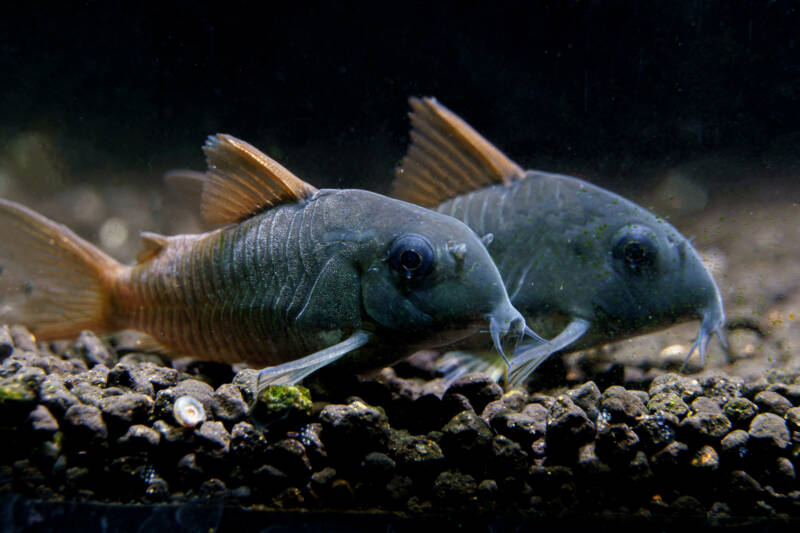
Among the myriad of species ranging from the prolific Albino Cory to the rare Orange Laser Cory, these peaceful fish would make an excellent addition to any community aquarium.
With the highly sensitive barbels they have on either side of their mouth, finding loose scraps of food is an easy task.
They spend most of their time shuffling around face first at the bottom of the tank. Consequently, corydoras should be kept on a soft sand substrate, as too much time sifting on a rough substrate can cause damage to the barbels.
These fish can be found in schools of hundreds and even thousands of members in the wild, and it is important to replicate this in the aquarium. House your corydoras in proper schools to make them more comfortable and be able to perform their natural behaviors.
1. Green or Bronze Corydoras (Corydoras aeneus)
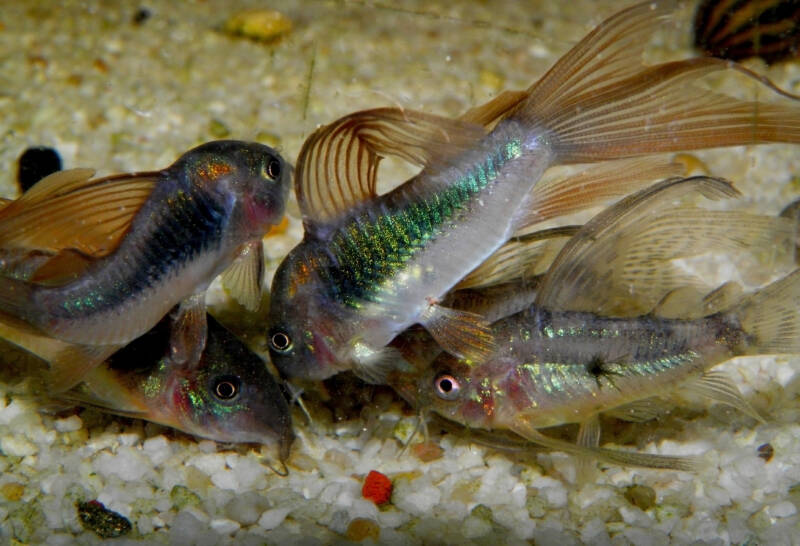
- Size: 2.75 inches (7 cm)
- Minimum Tank Size: 20 gal (75 l)
- Minimum School Size: 6-8
- Temperature: 72-79°F (22-26°C)
- pH: 6.0-7.0
- Diet: Omnivorous, live and pellet food suitable for catfish.
A very common species that can be found anywhere aquarium fish are sold. Bronze corydoras are easily recognized by the green iridescent coloration pictured above.
Very social animals, they are almost always tightly schooling with one another.
Green and all other corydoras originate from low oxygenated water and have evolved the ability to shoot up to the water’s surface and take a gulp of air before returning to the safety of the river bottom. Such behavior is often seen in the aquarium as well.
Although usually harmless, if you notice repeated darting to the surface from multiple cories in your pack you need to check your water quality. Poor quality can sometimes induce this behavior.
2. Peppered Corydoras (Corydoras paleatus)
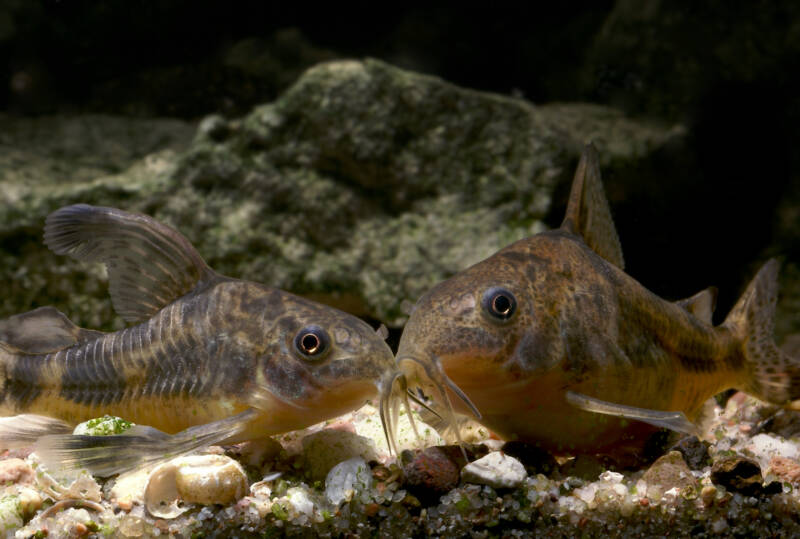
- Size: 2.3 inches (6 cm)
- Minimum Tank Size: 20 gal (75 l)
- Minimum School Size: 6-8
- Temperature: 72-79°F (22-26°C)
- pH: 6.0-7.0
- Diet: Omnivorous (live and pellet food)
These fish are characterized by their black and gray blotched markings. They tend to be slightly less stocky in body shape in comparison to other species.
Have you ever seen a corydoras wink? It seems unlikely since these animals do not have eyelids. The behavior exhibited does resemble a “wink”, but what the corydoras is actually doing is swiftly rolling its eyes.
The exact reason why they roll their eyes is unknown. Some speculate that rapid eye movement aids in detecting predators or food, others believe that Cory is using its eyeballs to push down food or air like a frog.
3. Pygmy Corydoras (Corydoras pygmaeus)
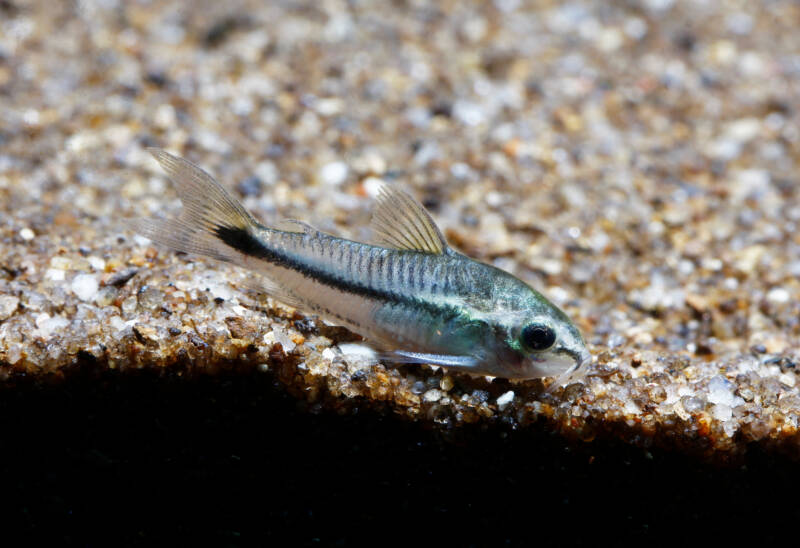
- Size: 1 inch (2.5 cm)
- Minimum Tank Size: 15 gal (57 l)
- Minimum School Size: 10
- Temperature: 72-78°F (22-25.5°C)
- pH: 6.0-7.0
- Diet: Omnivorous (live, frozen/thawed, and pelleted foods)
Also known as the Salt and Pepper Cory, Pygmies are the smallest of their genus. Do not be fooled by their size.
While most recommend 10 gallons as the minimum for Pygmy Corydoras, a more appropriate tank size would be between 15 and 20 gallons.
These fish are substantially more active than other corydoras and spend a large amount of their time darting around, using every inch of their tank space. Because of this, they require about the same tank size as other, larger Corydoras.
4. Sterbai Corydoras (Corydoras sterbai)
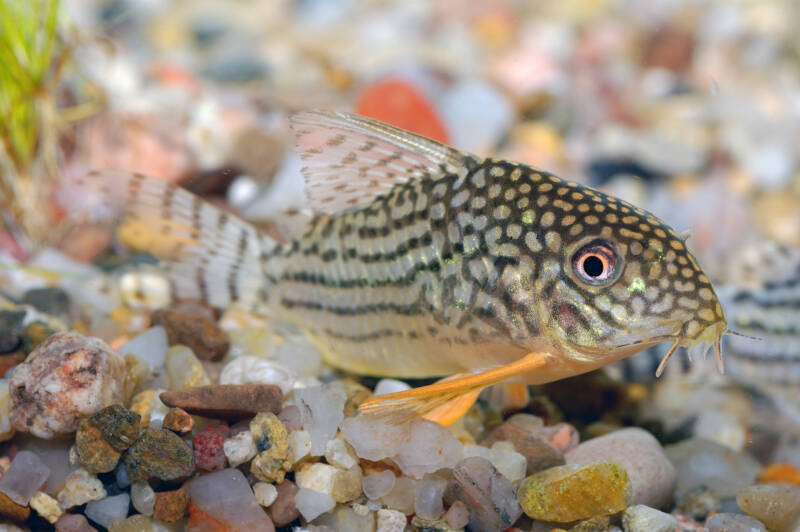
- Size: 2.5 inches (6.4 cm)
- Minimum Tank Size: 20 gal (75 l)
- Minimum School Size: 6-8
- Temperature: 72-78°F (22-25.5°C)
- pH: 6.0-7.0
- Diet: Omnivorous, a quality sinking pellet food supplemented with live foods.
This particular species of corydoras hails from the Rio Guapore which runs through Bolivia and Brazil. Though harder to find at your local fish store, the Sterbai’s unique, bespeckled coloration makes them a well sought-after addition to any tank.
This variety is commonly mistaken for the Harald Schultz Corydoras (Corydoras haraldschultzi) and it’s easy to see why.
To distinguish the species from one another, note the differing patterns. The Sterbai’s pattern is characterized by white markings on a black body, whereas the Harald Schultz’s pattern is the exact opposite: Black markings on a white body.
5. Orange Laser Corydoras (Corydoras sp. CW010)
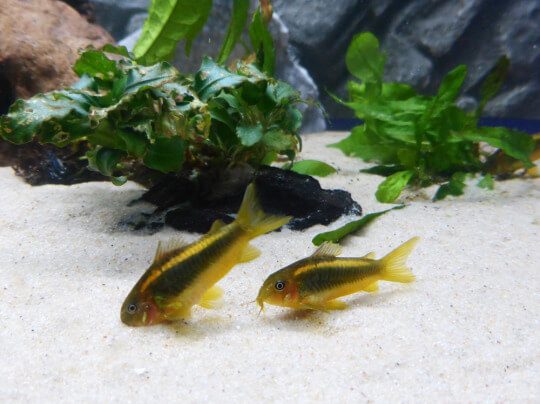
- Size: 3 inches (7.6 cm)
- Minimum Tank Size: 20 gal (75 l)
- Minimum School Size: 6-8
- Temperature: 72-78°F (22-25.5°C)
- pH: 6.0-7.0
- Diet: Omnivorous (live, pellet, and wafer food acceptable)
Orange Laser Corydoras belong to one of the few unidentified species of corydoras that exist. Both scientists and hobbyists suspect that they belong to Corydoras aeneus or Corydoras melanotaenia, but further research is needed.
The vibrancy of the orange color can differ from one fish to the next. Orange Laser Corydoras have a noteworthy resemblance to the Bronze Corydoras with their greenish-colored bodies. Yet, the striking neon orange stripe down the back of this corydoras is what separates them from the rest of the pack!
Synodontis Catfish
Synodontis are African catfish, known for their peculiar look and interesting abilities.
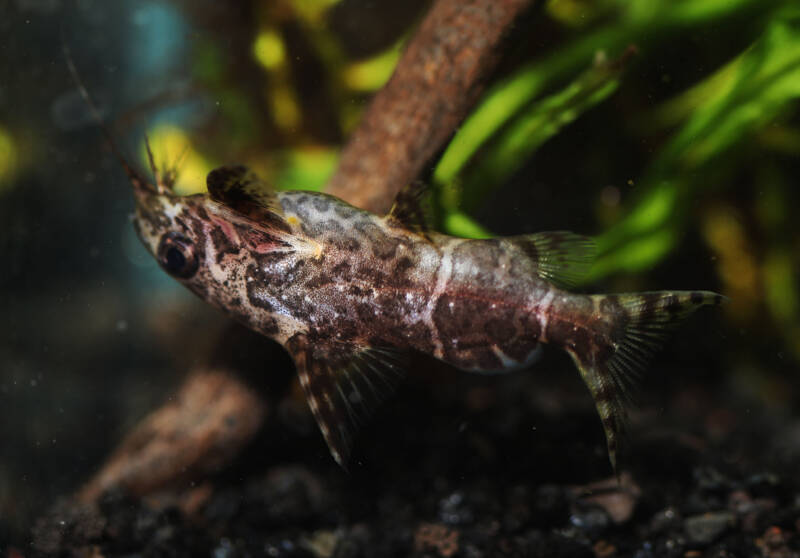
Most, if not all, species of Synodontis have the skill of swimming upside down for easier access to food on the water’s surface or the underside of various hardscapes. Thus, earning the genus the nickname of “Upside-down catfish”.
This widely used pseudonym is also the chosen name for a very specific species of Synodontis, the Synodontis nigriventris, so one may need to specify just which species they are referring to avoid confusion.
It is not uncommon for aquarists to also call these guys “squeakers” because of their unique ability to make a squeaking sound when threatened or otherwise distressed. They make this sound, not with their mouths, but with bones in their pectoral fins!
With over 100 species of Synodontis to choose from, picking the right one to add to your aquarium can be a daunting task!
6. Clown Synodontis (Synodontis decorus)
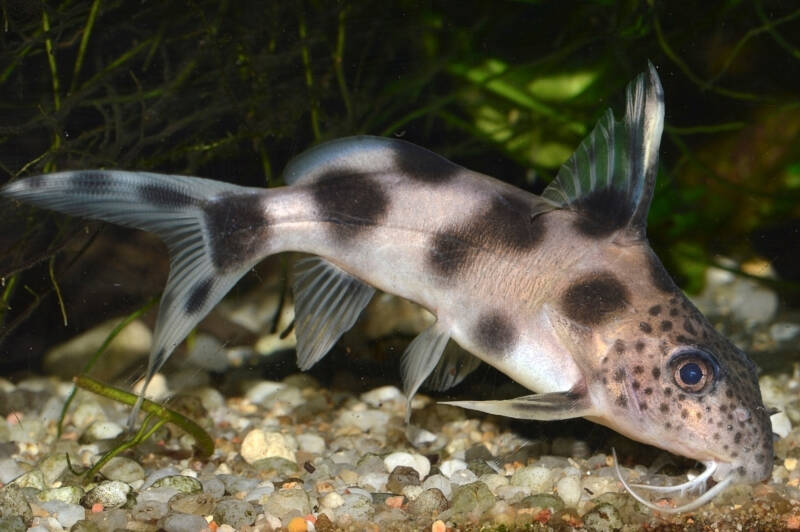
- Size: 10 inches (25 cm)
- Minimum Tank Size: 75 gal (284 l)
- Minimum School Size: One. Not required to be kept in schools.
- Temperature: 72-82°F (22-28°C)
- pH: 6.0-8.0
- Diet: Omnivorous, not picky eaters. Live food preferred but quality pellet food is also acceptable.
The Clown Synodontis can be easily distinguished from others of its genus by noting the long trailing extension off of the dorsal fin that appears on adults.
Another distinction of the Clown Synodontis, or Clown Squeaker, is the difference in the pattern of the head versus the rest of the body.
The head is covered in almost microscopic, densely packed black dots, while the rest of the body is a milky white color with much larger and more dispersed black blotches.
Patterns on other species of Snynodontis tend to be the same from the head to the tip of the tail.
It is best advised to not keep Clown Squeakers with small fish as they can fall prey to the larger Syno. Although not aggressive, they are best kept with larger fish such as cichlids to avoid the unnecessary death of smaller tank mates.
7. Alberti or “Bigeye Squeaker” Catfish (Synodontis alberti)
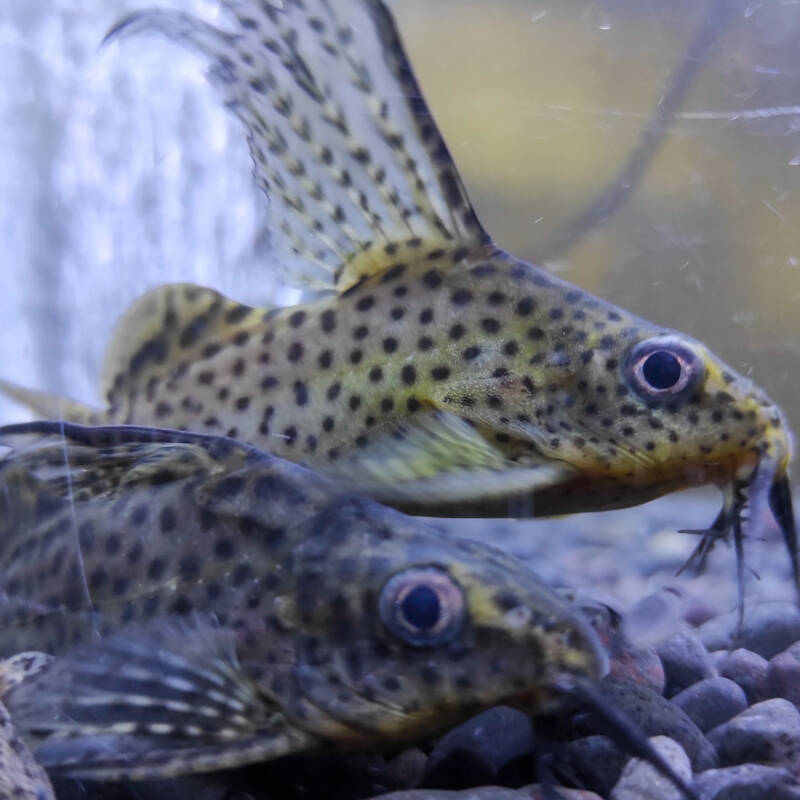
- Size: 8 inches (20 cm)
- Minimum Tank Size: 55 gal (208 l)
- Temperature: 72-81°F (22-27°C)
- pH: 6.0-8.0
- Diet: Omnivorous. Algae, pelleted foods, live foods, and blanched vegetables like zucchini make up this species’ diet.
The hardiness of the Alberti makes it one of the best beginner Synodontids.
They have some of the largest barbels of their group, and large eyeballs as well. Both of which come in handy when you’re a nocturnal fish and need to find food and avoid predators in the dark.
Even in the daytime Bigeye Squeakers are still not too fond of strong light so top floating plants are recommended to help keep the light levels down.
Unlike the Clown Syno, the Alberti is a shyer fish that should not be housed with aggressive cichlids. Instead, these guys would rather prefer being housed with smaller, more peaceful top tank dwellers.
The long feelers on this catfish can get in the way of other bottom dwellers. A heavily planted aquarium with plenty of caves or hides is also a must with this species.
Plecostomus
The Plecostomus is native to South America, and depending on the species can be found in Brazil’s Rio Negro, Rio Xingu, and Amazon rivers.
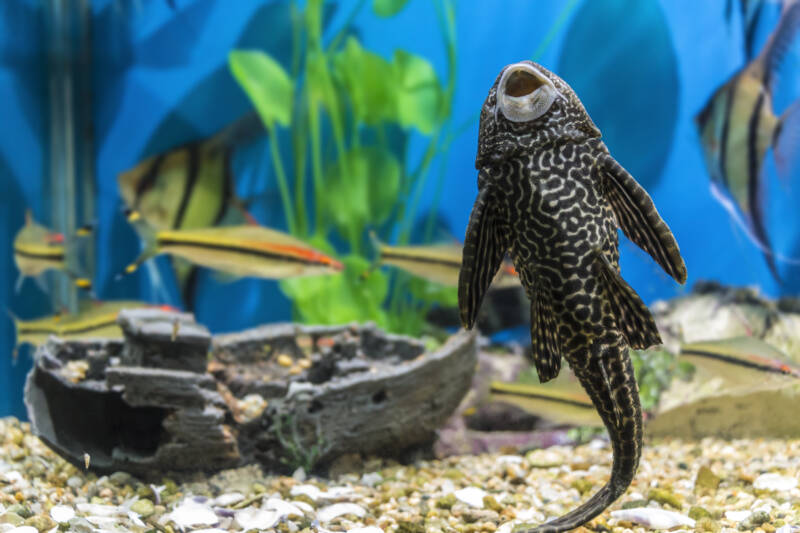
In their natural environment, Plecostomus prefer fast-moving, oxygenated waters with plenty of rock. In the aquarium, it is important to replicate that environment.
Driftwood is also an important staple in Pleco aquariums. Some species consume wood by sucking off the outer layers with their specialized sucker mouths!
Unfortunately, due to the sheer amount of fish being illegally released in local waterways the Common Pleco has become an invasive species in the southern United States.
Rivers and streams that were once free of the plecostomus, are now so inundated with these fish that native species are threatened. The incursion of the pleco is so serious that local officials have been known to encourage fishermen to capture and kill these fish.
8. Common Pleco (Hypostomus plecostomus)
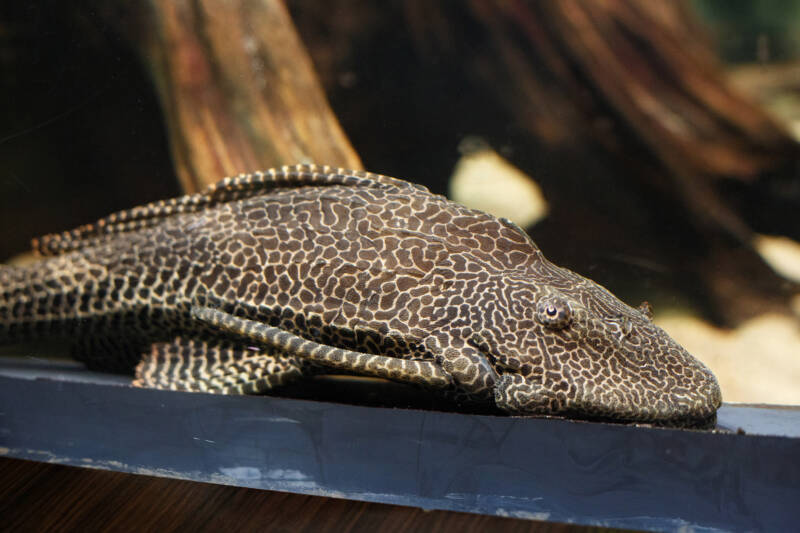
- Size: Known to reach 24 inches (61 cm) in the wild, although more likely to only reach about 12-16 inches (30-40 cm) in captivity.
- Tank Size: 200 gal (757 l)
- Temperature: 72-86°F (22-30°C)
- pH: 6.0-7.0
- Diet: Herbivore (live algae, zucchini, cucumber, algae wafers, and veggie wafers are acceptable)
As the name suggests, common plecos are the most prevalent pleco in the fishkeeping hobby. Undoubtedly, the common pleco is also one of the most abused fish. Novice fish keepers are known to house these catfish in inappropriately sized tanks, not realizing just how large they get.
9. Bristlenose Pleco (Ancistrus cirrhosus)
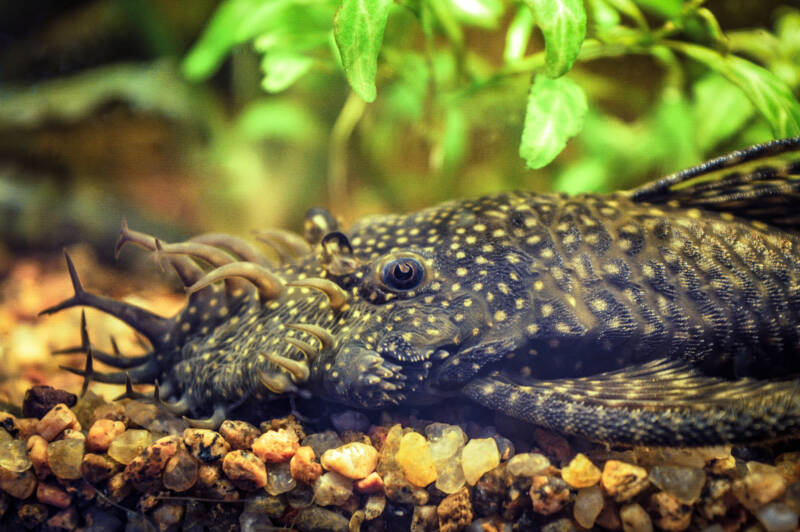
- Size: 5 inches (13 cm)
- Minimum Tank Size: 40 gal (151 l)
- Temperature: 72-86°F (22-30°C)
- pH: 6.0-7.0
- Diet: Herbivore. Feeds on algae and plant matter in the wild. In captivity, zucchini, cucumber, veggie wafers, algae wafers, and good old live algae are usually fed.
The bristlenose is a more appropriately sized pleco for captive life. Maxing out at around 4 or 5 inches (10-13 cm), they are a more suitable fish for aquariums than Common Plecos.
They can be easily identified by the tentacle-like sensory organs located on the face. Males and females of this species can be differentiated by noting the placement of “bristles”.
Females typically only have bristles around their mouths, while males have more profound bristles that cover most of the facial area. The standard Bristlenose is typically black, but albino and orange fish are also available.
Bristlenose Plecos are non-violent fish, very suitable for community aquariums. Proper aquariums should include plenty of hardscapes for the plecos to hide in. Be generous with driftwood and rocks, making sure to provide plenty of caves and places to take cover.
10. Golden Nugget Plecostomus (Baryancistrus xanthellus)
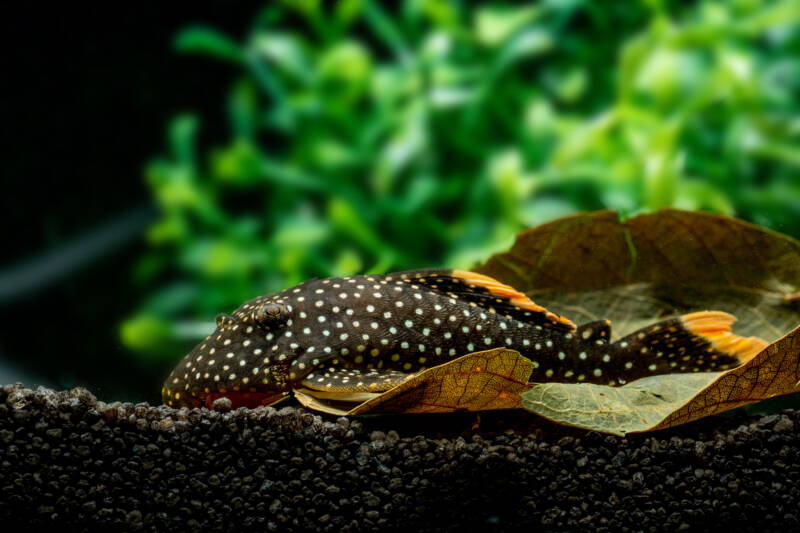
- Size: 14 inches (35 cm)
- Minimum Tank Size: 100+ gal (378+ l)
- Temperature: 77-86°F (25-30°C)
- pH: 6.5-7.5
- Diet: Omnivorous (frozen/thawed, wafers, pellets, zucchini, and cucumber)
Golden Nugget Plecos are a more rare species of Loricariidae and considerably more pricey as well. There are three different variants of the Golden Nugget: L018, L081, and L177. All of which can be found in several locations along the Amazonian Rio Xingu.
Like all plecos, Golden Nuggets only thrive in aquariums that mimic a South American river biotope. Decent current, live plants, and plenty of wood and rocks to take refuge in are a must.
Another important quality to mention is that this fish requires protein in their diet. Golden Nugget Plecos are known for having problems with malnutrition. Occasionally adding crustaceous meals will make this fish one happy omnivore!
Behaviorally, Golden Nugget plecos are territorial to other bottom dwellers but show no ill will towards the top and middle tank dwellers. If you are wanting more than one pleco in a single aquarium, you will need to provide extra caves and places to hide to give the fish room to get away from one another if need be.
Playing it safe here by not cohabiting is the better option. Golden Nuggets have been observed to fight each other for a prolonged time.
11. Royal Panaque (Panaque nigrolineatus)
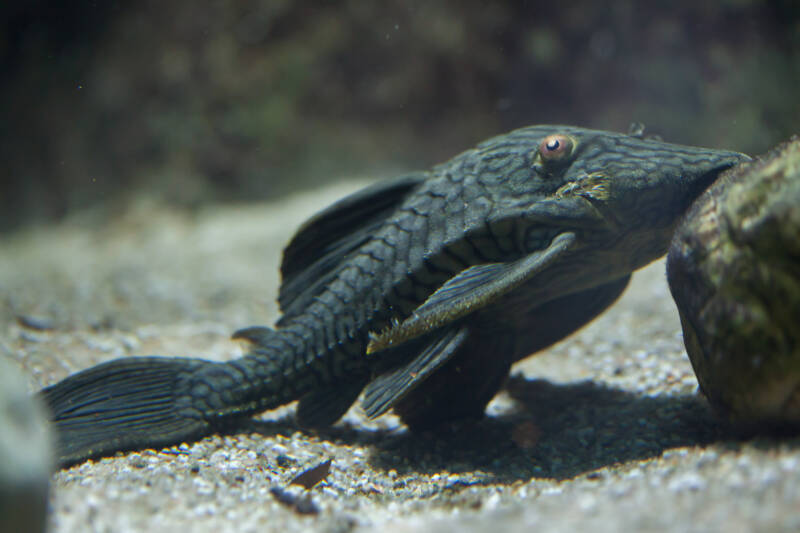
- Size: 14 inches (35 cm)
- Minimum Tank Size: 150 gal (568 l)
- Temperature: 72-86°F (22-30°C)
- pH: 6.0-7.0
- Diet: Herbivore (wood, zucchini, cucumber, shelled peas)
Royal Panaques, or Royal Plecos, are undoubtedly one of the most beautiful and unique specimens of the genus. Plecostomus enthusiasts are readily drawn into the blue-green color of this species.
Much like the Golden Nugget Pleco, Royal Panaques are also known to be territorial with other bottom dwellers and plecostomus.
To maintain stable water conditions, a strong filter is needed. Royal Panaques, as well as any large plecostomus, exude a significant amount of waste. Regular aquarium cleaning would be beneficial to the health of this fish and any other tankmates.
This species is assuredly one of the wood-eating varieties, bountiful driftwood and bogwood are needed for the Royal Panaque to thrive.
Other Popular Aquarium Catfish
12. Pictus Catfish (Pimelodus pictus)
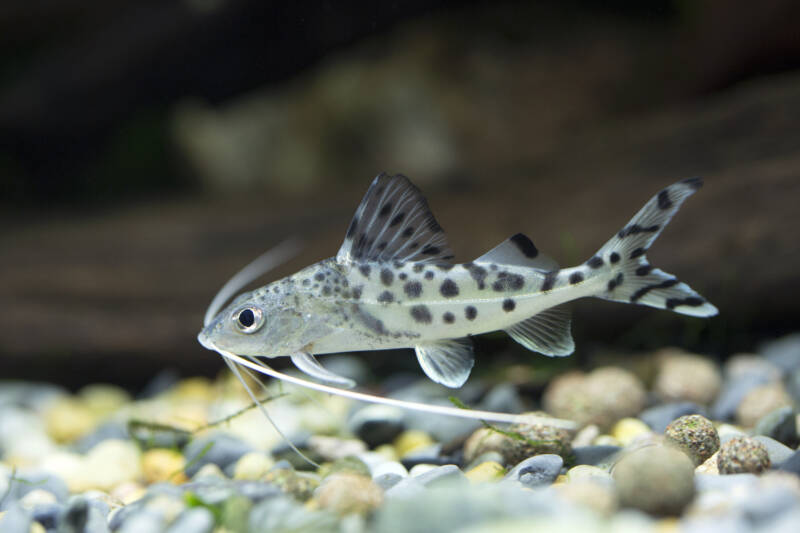
- Size: 6 inches (15 cm)
- Minimum Tank Size: 55 gallons (208 l), with 100+ being preferred
- Minimum Shoal Size: Can be kept alone, but appreciate being kept in groups of 3-4 in a proper sized aquarium.
- Temperature: 72-78°F (22-25.5°C)
- pH: 7.0
- Diet: Omnivorous, not picky (live, pelleted, frozen, and blanched vegetables)
Pictus cats are naturally found shoaling in warm, sand-bottomed rivers in South America. Pictus cats are very active, fast swimmers and thusly should be housed in a larger tank.
Kept singly, it is said to be okay for these guys to be housed in smaller tanks like 55 gallons, but that is the bare minimum as these fish really should have more space to swim as they please.
When it comes to tank size, no matter the species, bigger is always better! When keeping multiple Pictus in one tank, it is recommended that they are kept in no less than 150-200 gallons (567-757 l).
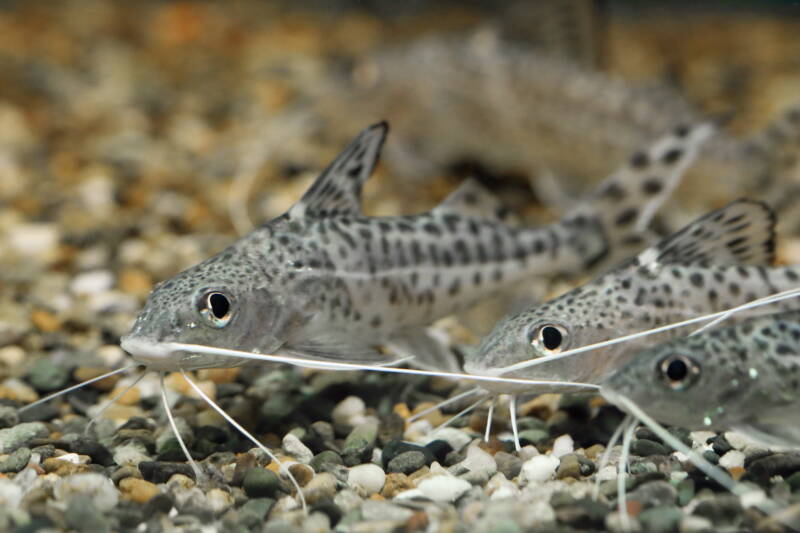
Other aquarium requirements with this species include moderate water flow, plenty of plant cover with accessible hides, and a soft sandy substrate.
The amount of waste released by this species should also be kept in mind, as it will be imperative for the tank to have a powerful filtration system to keep these scaleless and sensitive fish healthy.
The tank lights should be kept low, or obscured by floating plants, as Pictus cats are nocturnal and can get stressed by too bright light.
13. Glass Catfish (Kryptopterus minor)
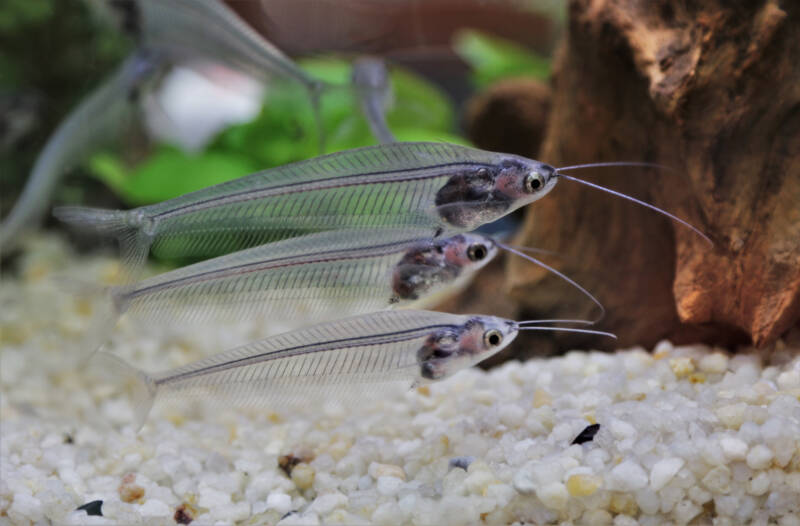
- Size: 4 inches (10 cm)
- Minimum Tank Size: 30 gal (114 l)
- Minimum Shoal Size: 6-8
- Temperature: 72-82°F (22-28°C)
- pH: 6.0-7.0
- Diet: Omnivorous (daphnia, brine shrimp, small worms, pellet, and flake foods)
The Glass Catfish, also recognized as the Ghost Catfish, gets its name from its amazingly see-through, glass-like body.
Kryptopterus, the name of the genus, derives from the Greek words “kryptos” and “pterýgio”. Words, consecutively, meaning “hidden” and “fin” in regards to their apparent lack of a dorsal fin.
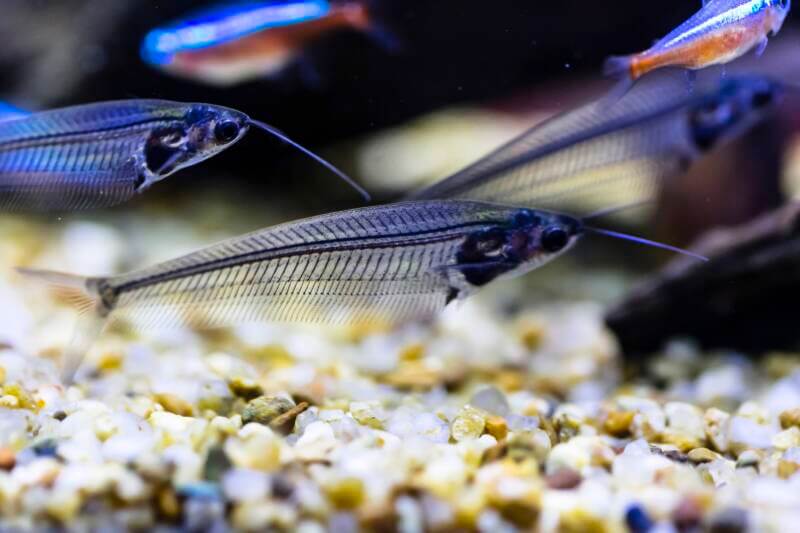
Perfect water parameters are a must. These fascinating fish are notably sensitive and should not be added to new aquariums. An established tank with stable water parameters is paramount to the health of glass cats.
Originating from fast-moving streams in Southern Asia, Glass Catfish require a medium to high flow in their aquarium. It is also recommended that the tank be fully planted with plenty of cover as these fish are also known for being quite shy.
14. Redtail Catfish (Phractocephalus hemioliopterus)
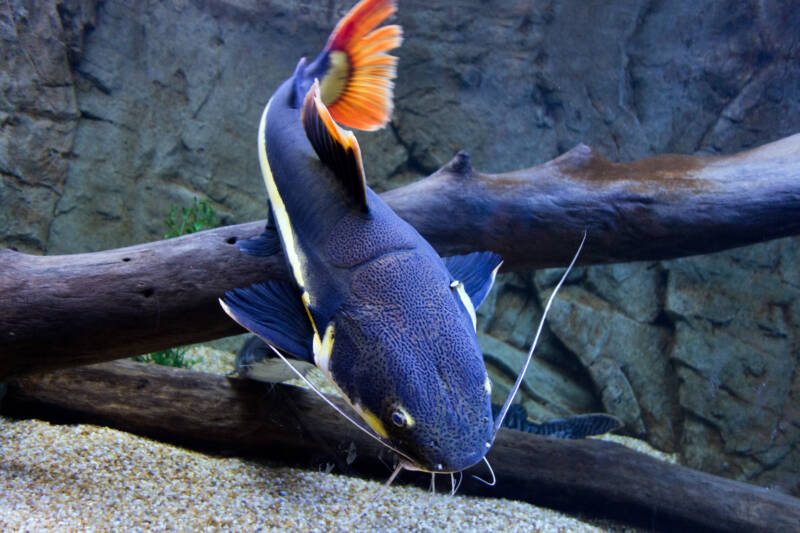
- Size: 3 to 4 feet/0.9-1.2 m (up to 5 feet in the wild)
- Minimum Tank Size: 1,500 to 2,000 gallons (5678-7570 l) for a single fish
- Minimum School Size: single or a pair
- Temperature: 68-80°F (20-26.6°C)
- pH: 6.0 to 7.5
- Diet: omnivorous, mostly meat (worms, small fish, and shrimp), fruits, vegetables
The redtail catfish is another large species from northern South America. It is easily recognizable by its wedge-shaped body, which is dark grey on the back and beige on the belly, and its striking red tail.
These fish live up to 15 years in captivity and quickly grow to be extremely large. Consider the requirements to filter, heat, and clean the enormous tank they need to thrive.
Redtails are destructive and can break up or consume any plants, decorations, and driftwood in their habitat, including things like heaters and filters.
Picking tank mates for this fish is difficult. It is a natural predator, so avoid smaller fish. Adding peaceful fish of similar size is an option, but that increases the minimum tank size.
One of the easiest things about redtail catfish is feeding them. They are not picky and will take a balance of live and frozen meaty foods. When they are young, they eat every day, but as they grow, only once or twice a week.
15. Otocinclus or Oto Catfish
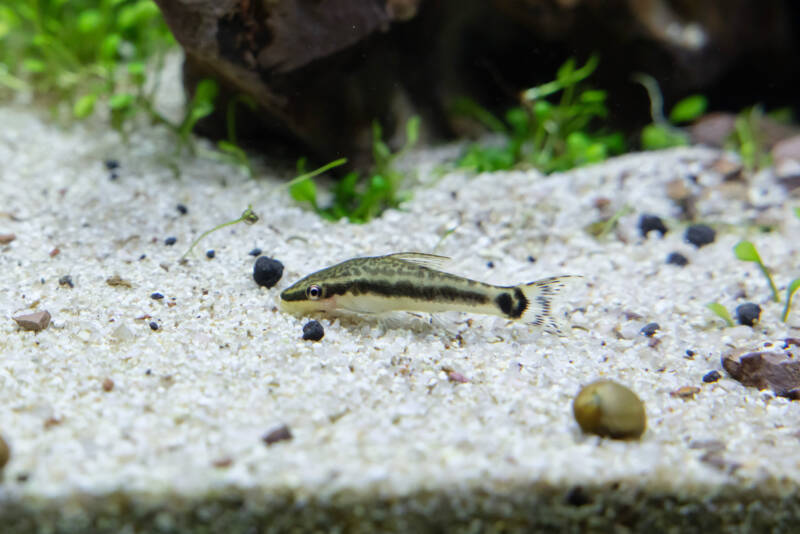
- Size: 1.5 – 2 inches (4-5 cm)
- Minimum Tank Size: 20 gal (75 l)
- Minimum Shoal Size: 3-5
- Temperature: 72-82°F (22-28°C)
- pH: 6.0-7.5
- Diet: Herbivore. Live algae are the main staple in their diet but may be able to add zucchini or cucumber as well.
Many hobbyists enjoy keeping Otocinclus Catfish because of their stunning ability to demolish algae as it makes up a majority of this fish’s diet.
It is important to have a steady supply of algae in your oto tank at all times, too little and the fish can become malnourished. To make sure there is an adequate amount of sustainable algae, leaving the tank lights on for at least 12 hours a day should do the trick.
It may also be necessary to grow more algae in a separate tank or a small container on a window sill. Some keepers manage to successfully add blanched vegetables such as zucchini and cucumber to their Oto’s diet, however, this may not be possible with all Otos. They are picky fish!
Otos spend most of their day grazing with their pleco-like sucker mouths! They are active fish, said to be darting about the tank with ease.
Otos can be cohabitated with various small fish and invertebrates. Very peaceful, these catfish tend to stay out of the way of other fish.
16. Chinese Algae Eater (Gyrinocheilus aymonieri)
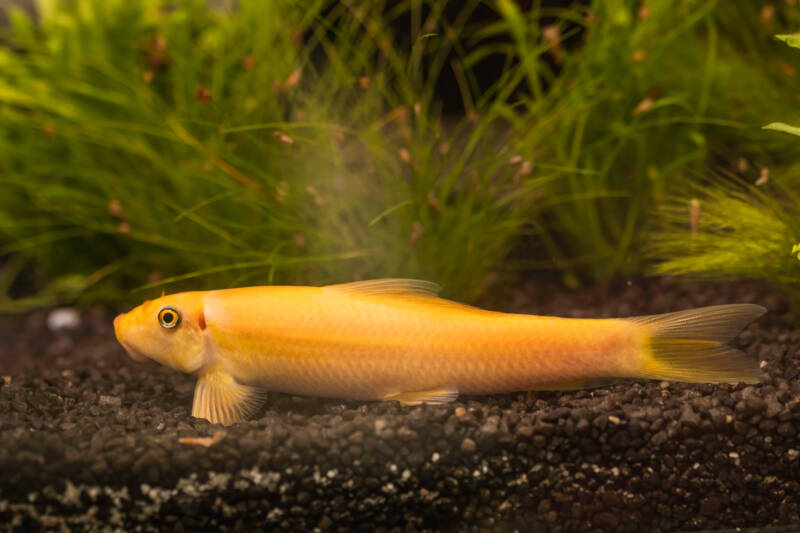
- Size: 5 to 10 inches (13-25 cm), depending on tank conditions
- Minimum Tank Size: 30-50 gallons (113-189 l)
- Minimum School Size: keep as a single member of its species
- Temperature: 74-80°F (23-26.6°C)
- pH: 5.8-8.0 (6.5-7.5 best)
- Diet: omnivorous (algae, live foods, blanched vegetables)
The Chinese algae eater also called the honey sucker or sucking loach, is closely related to catfish but scientifically classified in the family of loaches. Nevertheless, this quirky fish has similar tank cleaning benefits combined with its long, 10-year lifespan and hardy nature.
This fish is best kept as the sole member of its species in a large tank to reach its full growth potential. Keep the water well filtered to avoid the buildup of nitrates and the current strong.
Good tank mates are those occupying the middle to upper levels of the water column, such as danios, tetras, and gouramis.
They can be aggressive toward fish of similar color and size or slower-moving fish. Do not house them with flat-bodied fish, such as angelfish, as they can attach to and feed off them.
These omnivores have changing nutritional needs as they age and require supplementation of their diet with protein-rich live foods, algae wafers, and blanched vegetables. Their aggression can also increase as they age.
17. Tiger Shovelnose (Pseudoplatystoma fasciatum)
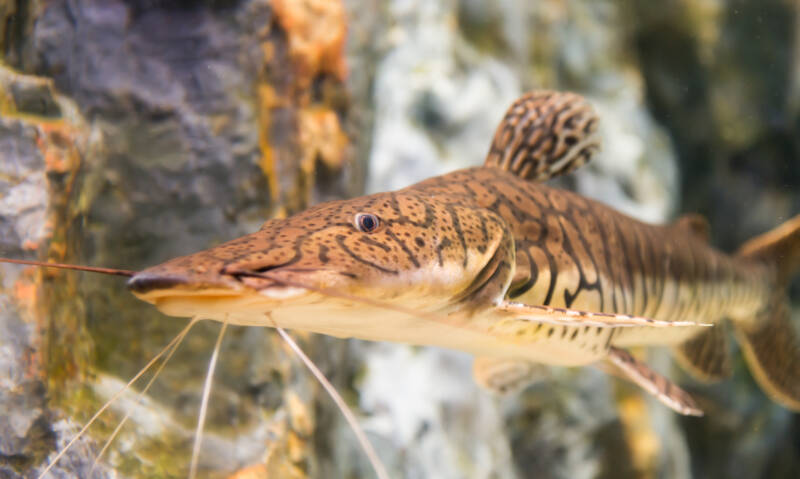
- Size: 2.5 to 3 feet (0.7-0.9)
- Minimum Tank Size: 250 gal (946 l)
- Minimum School Size: one or two, depending on tank size
- Temperature: 75-82°F (24-28°C)
- pH: 6.0-8.0
- Diet: omnivorous, but mostly meat-based
The tiger shovelnose catfish is another species with a unique appearance. It has a slender body and a long, flat nose trimmed with flowing barbels to navigate their dark and silty native waters.
Their tiger name comes from a silver/gold-colored body with stripes and spots.
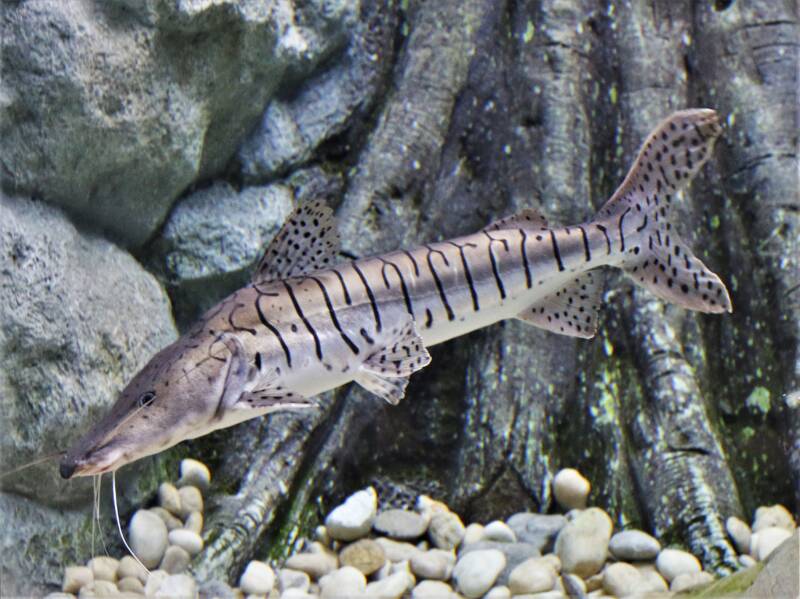
They are hardy and can live a long time, anywhere from 18 to 25 years. Fast-growing, a newly purchased 4-to-6-inch (10-15 cm) fish can quickly reach a length of up to 3 feet (0.9 m). Plan on a significant investment in a big tank.
Their primary diet in the wild is smaller fish and crustaceans. In an aquarium, they need a good mix of live and frozen meaty foods, with some vegetables or sinking pellets once and a while.
This active fish occupies all levels of the tank. Pair it with fish of equal size and temper. If you keep more than one tiger, ensure each can establish a territory. Keep the aquarium lid secure, as this strong species can leap.
18. Twig Catfish (Farlowella vittata)

- Size: 6 to 8 inches (15-20 cm)
- Minimum Tank Size: 20 gallons (75 l), add 10 gallons (38 l) for each additional fish
- Minimum School Size: singly or in small groups
- Temperature: 75-79°F (24-26°C)
- pH: 6.0-7.0
- Diet: mostly herbivorous (wafers, blanched vegetables, occasionally frozen meaty foods)
The twig catfish is arguably one of the most unique in appearance. True to its name, it has a long, thin, stick-colored body. It spends most of its time stationary, attached to an object by its sucker mouth and blending into the surroundings.
These fish can live anywhere from 5 to 15 years with proper care. They need very clean and well-oxygenated water to thrive.
Twig catfish are shy and risk being outcompeted for food. Pair them with equally tempered, slow-swimming species, such as neon tetras, invertebrates, or snails, to ensure they get enough to eat.
Unlike other species of catfish, the hardy twig will readily breed in a community tank.
Males can become territorial when mating and will protect both the eggs and the newly hatched fry. Make sure the fry get plenty of small-sized foods to eat as the loss of fry due to starvation is fairly common.
19. Asian Stone Catfish (Hara jerdoni)
- Size: 1 inch (2.5 cm)
- Minimum Tank Size: 15 gal (57 l)
- Minimum Shoal Size: 3-5
- Temperature: 72-78°F (22-25.5°C)
- pH: 6.0-7.2
- Diet: Small live foods including daphnia and bloodworms.
Asian Stone cats are a perfect nano aquarium fish. They’re small, have a low level of activity, and a lovely rock-like appearance.
Hara jerdoni are very shy catfish, rarely seen out during the day, yet are known to become more confident when kept in groups of 3-5. They can become easily overtaken by larger fish. If you are interested in cohabitation make sure to choose small, unintrusive tankmates.
Being another sensitive fish, stable water conditions are crucial in keeping this species healthy. Any sudden shift in parameters, including oxygen levels, can be hazardous.
Preferring to spend the daylight hours nestled in among the plants, Stone Cat aquariums should be stocked with low-light plants including mosses, java fern, and anubias. It is documented that they prefer sand substrate over the harsher rock and gravel.
20. Bumblebee (Microglanis iheringi)
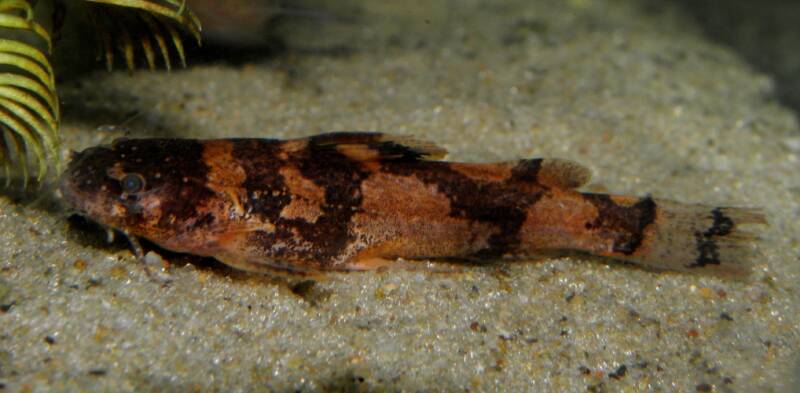
- Size: 3 inches (7.6 cm)
- Minimum Tank Size: 20 gallons (76 l), add 10 gallons (37 l) for each additional fish
- Minimum School Size: singly or in small groups
- Temperature: 70-77°F (21-25°C)
- pH: 6.5 to 7.5
- Diet: omnivorous (sinking pellets or wafers, spirulina, blanched vegetables, live or frozen meaty foods)
The bumblebee catfish hails from the northern part of South America. It features the black and yellow banding of its namesake, a forked tail, large barbels, and a wide mouth. They use their large ventral fins to scoot along the substrate and scavenge for food.
This nocturnal species spends most of its time hiding, so you can get away with a smaller tank. Creating ample rocky or driftwood hiding spaces is essential. If your bumblebee cannot hide during the daytime, they will be constantly stressed.
Bumblebees are peaceful and can be paired with species of similar size and temperament. They are not picky and eat anything from algae and plant matter to insects and larvae. Avoid housing them with neon tetras, invertebrates, and fish fry, as your fish may eat them.
This fish lives up to five years, is extremely hardy, and is not susceptible to common freshwater tank ailments if their water is kept clean and well oxygenated.
Closing Thoughts
As a whole, freshwater catfish are excellent fish to keep. The few listed above are just a fraction of catfish available.
No matter the size of your tank or the size of your wallet, there is a catfish for you!
